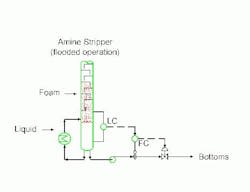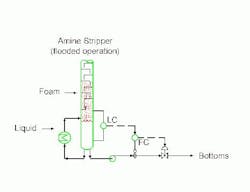Do your level best with foam
System inventory control is one of the basics of stable and effective column control. Pressure control regulates vapor inventory. Level control regulates liquid inventory. Improper liquid level causes many expensive operating problems. If the level is too low, pump cavitation may occur and lead to seal leaks, which not only increase maintenance costs but also can lead to fires, massive unit upsets and danger to personnel. High liquid level may result in tower flooding and tray damage. Additionally, poor liquid-level control reduces the effectiveness of advanced control systems. Decoupled control systems depend upon using liquid inventory changes to dynamically compensate for control disturbances while minimizing regulatory changes to the system. Control calculations use an assumed liquid density to determine the liquid level inside the vessel.
Foaming systems are particularly difficult for accurate liquid-level measurement because foam has a lower density than the foam-free liquid. In an amine stripper, foam caused the tower to flood (Figure 1). This plant lost an overhead accumulator full of liquid at least once and often twice per week. Foam entrainment forced the column to operate at lower capacity or product purities.
Many different devices can be used to measure liquid level. However, differential pressure (DP) cells, due to their low cost and wide applicability, are the most common. DP cells are very similar to sight glasses. Data from DP cells are interpreted in the same way. Understanding how sight glasses can fool us explains how the process fools the DP cell. The immediate response on seeing a sight glass is that it shows the liquid level in the vessel. In reality, the sight glass is a DP cell. The sight glass measures the DP inside the vessel and reports that DP to us in a height of liquid that we see in the sight glass. The DP generated inside the tower is the height of liquid times the liquid density inside the tower. However, the height shown in the sight glass outside the tower is the DP divided by the density outside the tower.
Obviously, if the liquid in the sight glass has the same density as the liquid in the vessel, the reading in the sight glass is accurate. However, with foam, the higher liquid density in the sight glass generates a lower level than the foam actually creates inside the tower (Figure 2).
By Andrew Sloley, contributing editor
[email protected]


